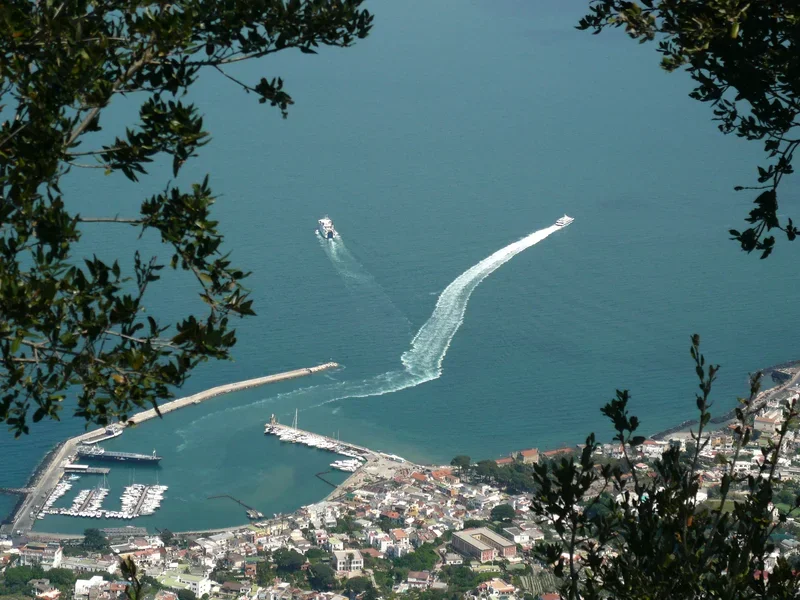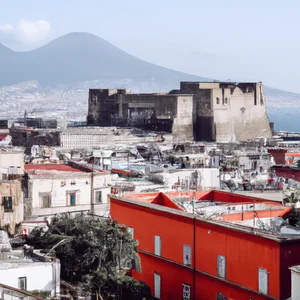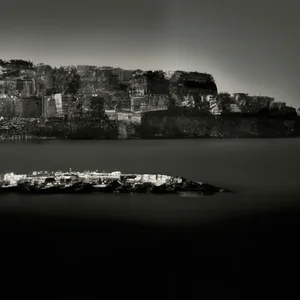Book your experience
Palazzo Donn'Anna
Palazzo Donn’Anna, located along the magnificent Lungomare di Napoli, is one of the architectural gems of the city, rich in history and charm. Built in the 17th century, the palace is not only an extraordinary example of Baroque architecture, but is also shrouded in stories and legends that enrich its cultural significance. The imposing structure, with its breathtaking view of the Gulf of Naples and Vesuvius, is testimony to a bygone era, when nobles and aristocrats populated the city and the palace itself was a hub of social and cultural life.In this article we will explore ten fundamental aspects of Palazzo Donn’Anna, starting from its fascinating history, which is intertwined with significant political and social events. We will analyze the architecture and design that characterize the building, with particular attention to the elements that make it unique in the Neapolitan panorama. Its privileged position and enchanting views offer an ideal context for a visit, and we will not fail to delve into the legends and myths that surrounded the figure of Donna Anna Carafa, the noblewoman who commissioned the construction of the building.Furthermore, we will discuss the historical importance of the palace, its renovations and restorations that have sought to preserve its splendor over the centuries. There will be no shortage of information on the cultural events held inside and on the accessibility it offers to visitors. Finally, we will present some curiosities and suggestions on how to get to this extraordinary place, which represents a fundamental chapter in Neapolitan history and culture. Palazzo Donn’Anna is therefore not only a place to visit, but an experience to live, a journey through time that passes through centuries of art, history and legends.
History of the Palace
The Palace in question, known as the Royal Palace of Naples, has a rich and fascinating history that has its roots in the Angevin period, when it was built in the 13th century as residence of the kings of Naples. Over the centuries, the palace has undergone numerous modifications and expansions, reflecting the various architectural styles and cultural influences that have followed one another in the city.
During the reign of the Aragonese, the Royal Palace became a symbol of power and royalty, becoming one of the main residences of the monarchy. In 1600, the palace was renovated in Baroque style, with the addition of sumptuous frescoes and decorations that enhanced its magnificence.
With the advent of the Bourbon dynasty in the 18th century, the Royal Palace became the center of the political and cultural life of Naples. It was in this period that the palace reached its peak of splendor, with the creation of gardens and richly decorated rooms, which hosted events of great importance.
Today, the Royal Palace of Naples is an important historical and cultural site, visited by thousands of tourists every year. It has been declared a World Heritage Site by UNESCO and continues to be a symbol of Neapolitan history and culture.
Architecture and Design
The Palace is an extraordinary example of architecture that reflects the different stylistic influences that have occurred over the centuries. Its construction began in the 15th century and continued until the 19th century, embracing styles ranging from Gothic to Renaissance >, up to baroque and neoclassical.
Facade
The façade of the Palace is characterized by a play of volumes and proportions that captures attention. The numerous windows, some of which are decorated with elaborate frames, and the wrought iron balconies, contribute to creating an atmosphere of great elegance. The upper part of the facade is adorned with sculptures and friezes that tell mythological and historical stories.
Interior
The interiors of the Palace are equally spectacular, with frescoed halls, crystal candelabra and floors in fine marble. Each room is a masterpiece of design, with period furniture and works of art that reflect the aristocratic taste of the era in which it was built.
Gardens and Courtyards
The Palace is surrounded by splendid gardens which offer a haven of tranquility in the heart of the city. The internal courtyards, with their fountains and exotic plants, are an example of how architecture can harmonize with nature.
Innovations and Sustainability
In the recent renovations, modern technologies were integrated to ensure the sustainability of the Palace. The use of eco-friendly materials and the adoption of energy saving practices have become an integral part of its contemporary design.
Location and View
The Palace, located in the heart of Naples, occupies a strategic position which makes it easily accessible and visible from different points of the city. Its privileged location allows you to enjoy a breathtaking view of the Gulf of Naples and Vesuvius, making it an ideal destination for tourists and visitors.
Access and Connections
The Palace is well connected by public transport, thanks to the proximity of several metro stops and bus lines. Its central location makes it a perfect starting point for exploring other historical and cultural attractions of Naples.
Overview View
From the Palace, it is possible to admire not only the sea and Vesuvius, but also the characteristic streets and squares of Naples, such as Piazza del Plebiscito strong> and the Castel dell’Ovo. The view is particularly evocative at sunset, when the sun paints the sky with warm colors and reflects its lights on the waters of the gulf.
Influence on Local Culture
The location of the Palace has had a significant impact on local culture, serving as a meeting point for social and cultural events. Its panoramic view has been a source of inspiration for artists and writers over the centuries, helping to create an indissoluble bond between the Palace and the beauty of Naples.
Legends and Myths
The Palace of Naples is surrounded by numerous legends and myths that are intertwined with its history and the culture of the city. One of the most fascinating stories concerns the figure of the ghost of Donna Anna, an elderly noblewoman who is said to wander the corridors of the palace in search of her lost lover. It is said that its presence is felt during full moon nights, bringing with it a mysterious and melancholy atmosphere.
Another popular legend is that of the hidden treasure in the palace, which is said to have been buried by the nobles during a period of crisis. This treasure, made up of jewels and precious objects, has attracted many fortune seekers over the centuries, but no one has ever managed to find it.
The mystery of the Tower
An intriguing element of the palace is its tower, which is shrouded in tales of its use as a prison. It is said that many political prisoners were locked up here, and that their tormented souls continue to wander within the tower’s walls. Some visitors claim to have heard moans and whispers coming from the tower, adding another layer of mystery to the place.
Rites and Traditions
The legends linked to the palace do not stop here; in fact, it is also at the center of some local traditions. Every year, on the occasion of particular holidays, rituals are held that celebrate the history and myths of the palace, attracting both tourists and residents. These events offer a unique opportunity to immerse yourself in Neapolitan culture and discover the stories that make the palace such a special place.
Historical Function
The Palace in question has played a crucial role in the history of Naples, acting as a nerve center for political, cultural and social events since its construction. Initially, the Palace was intended to be the residence of noble Neapolitan families, but over the centuries it took on different functions, reflecting the changing needs of Neapolitan society.
During the period of the Kingdom of Naples, the Palace became an important headquarters for government activities. Meetings between nobles and officials took place here, and the Palace itself was often at the center of political intrigues and diplomatic negotiations. Its strategic position contributed to making it a hub of the city’s public life.
With the advent of the modern era, the Palace continued to be a symbol of power and prestige. During the Risorgimento, it witnessed significant historical events, such as patriotic meetings and demonstrations in favor of the unification of Italy. During this period, the Palace also hosted prominent figures, including politicians, artists and intellectuals who contributed to the cultural and social growth of the city.
Today, the Palace not only retains its historical importance, but also serves as a space for cultural events and exhibitions, continuing to be a point of reference for the local community and tourists who wish to explore the rich history of Naples.
Renovations and Restorations
The Palace has undergone numerous renovation and restoration interventions over the centuries, reflecting the changes in the functional and stylistic needs of the period. The first significant renovations date back to the 18th century, when the palace was adapted to host noble events and official ceremonies. During these works, decorative and architectural elements were added which enriched the external and internal appearance of the building.
During the 19th century, the Palace was subject to further modifications aimed at modernizing its structures and improving its functionality. This period saw the introduction of technological systems that were advanced for the time, such as gas lighting and plumbing systems. These interventions allowed the Palace to maintain its relevance as a center of cultural and social attraction.
In the 1980s, following a period of abandonment and degradation, the Palace underwent an important conservative restoration project. The interventions aimed to bring to light original elements, such as frescoes and stuccos, while preserving the architectural structure. These works were fundamental in restoring the Palace to its ancient splendor and ensuring the safety of visitors.
Recently, new renovation projects have been launched to adapt the spaces to modern cultural needs. These interventions include the implementation of sustainable technologies and the adaptation of the exhibition spaces, making the Palace an accessible and welcoming place for an increasingly wider audience.
Each phase of renovation and restoration has contributed to preserving the history of the Palace, making it not only a place of architectural beauty, but also an important witness to the cultural and social transformations that have occurred in Naples over the centuries.
Cultural Events
The Palace in question is an important cultural center in Naples, hosting a series of events that celebrate the history, art and tradition of the city. Throughout the year, the Palace becomes a stage for art exhibitions, concerts and theatrical reviews.
Exhibitions and Exhibitions
The art exhibitions, held in different rooms of the Palace, range from contemporary to classical art, often featuring works by local, national and international artists. These exhibitions not only enrich the city’s cultural offering, but also attract tourists and art enthusiasts.
Concerts and Musical Reviews
The Palace regularly hosts concerts of classical, jazz and traditional Neapolitan music. Thanks to its exceptional acoustics and historic atmosphere, concerts here are unforgettable experiences. Musical festivals such as “Napoli Jazz Festival” and “Summer Concerts” are highly anticipated annual events.
Theatrical Events
Furthermore, the Palace hosts theatrical performances, ranging from drama classics to contemporary productions. These events are often promoted in collaboration with local theater companies, helping to keep the Neapolitan theatrical tradition alive.
Courses and Workshops
The Palace also offers courses and workshops for adults and children, ranging from art to music and theatre. These educational activities aim to involve the community and pass on local cultural traditions to new generations.
Local Festivals and Celebrations
On the occasion of local holidays, the Palace becomes a place of celebration, hosting special events that include markets, dance shows and artistic performances. These events offer visitors the opportunity to immerse themselves in Neapolitan culture and experience the vibrant atmosphere of the city.
In summary, the Palace is not only a place of architectural and historical interest, but is also a lively center of cultural events that contributes to making Naples one of the richest cities in culture and art in the world.
Accessibility
The Palace in question is located in a strategic position in the heart of Naples, making it easily accessible to visitors. The surrounding area is well connected by public transport, making arrival easier for both tourists and residents.
Public Transport
Numerous bus and tram lines serve the area, with stops in the immediate vicinity of the Palace. The subway is another convenient option, with several stops within walking distance. These include both lines 1 and line 2, which connect the Palace with other parts of the city and with the central station.
Accessibility for disabled people
The Palace is equipped with facilities for disabled people, including ramps and elevators that allow access to the upper floors. Guided tours can be organized to meet the specific needs of visitors with reduced mobility.
Parking
For those who decide to arrive by car, there are several parking areas nearby. However, it is advisable to use public transport, as traffic can be heavy and parking limited in the center of Naples.
Useful information
It is advisable to plan your visit in advance, checking opening hours and any restrictions related to special events. Furthermore, the presence of a tour guide can enrich the experience, providing detailed information on the history and characteristics of the Palace.
Curiosities
The Palace is full of curiosities that make it a fascinating place to visit. Here are some of the most interesting:
1. Hidden History
Many visitors do not know that the Palace has a hidden history linked to significant historical events, such as its functionality during the Second World War, when it was used as a safe haven for some local residents.
2. Artistic Influences
The Palace has inspired numerous artists and writers over the centuries. For example, the famous painter Caravaggio is said to have spent time here, seeking inspiration for some of his most famous works.
3. Unique Architectural Elements
A unique feature of the Palace is the presence of frescoes and decorations that have been preserved over time, offering a rare glimpse into the art and culture of the period in which it was built.
4. Nightlife
In recent years, the Palace has become a point of reference for night-time events, with themed evenings and concerts that attract visitors from all over the world, contributing to a rebirth of cultural life in the area.
5. Ghost Stories
It is said that the Palace is haunted by the spirits of ancient nobles, and several visitors have reported disturbing experiences, helping to fuel the legend and fascination around this place.
These curiosities not only enrich the history of the Palace, but also give visitors another reason to explore and discover all it has to offer. Don’t forget to ask your guides to tell you more interesting stories during your visit!
How to Get There
Reaching Naples and the Palace is quite simple thanks to its central location and the numerous means of transport available.
By Plane
If you arrive by plane, Naples-Capodichino airport is the main airport in the city. From the airport, you can take a taxi, which takes about 20-30 minutes to get to the city center, or use the Alibus bus service, which connects the airport with the Central Station and the historic center .
By train
If you travel by train, the Naples Central Station is well connected to the main Italian cities and also offers connections with the metro network. From the station, you can take a taxi or use the metro, line 1, to reach the Palace.
By Car
If you decide to arrive by car, Naples is well connected by motorways. It is advisable to use a navigator to find the best route and keep in mind that the center can be congested. Additionally, you may need to look for parking in the surrounding areas, as traffic can be heavy.
Public Transport
The public transport network in Naples is varied and includes the metro, buses and trams. The stops closest to the Palace are easily reachable and will allow you to explore other attractions of the city.
On Foot
If you are already in the historic center, the Palace can be easily reached on foot. Walking through the streets of Naples, you will also have the opportunity to discover other places of interest and savor the local culture.































